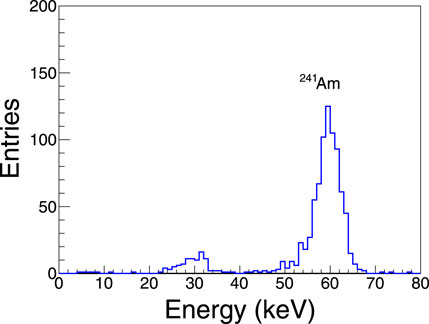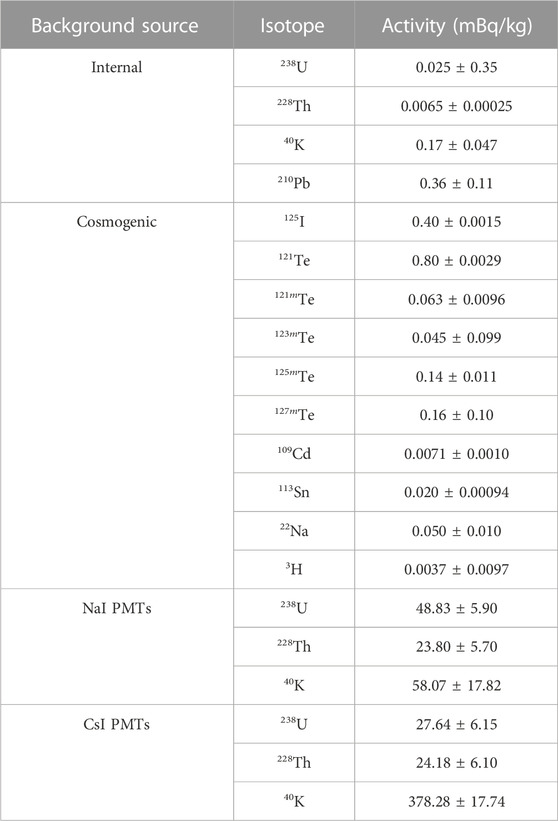- 1IBS School, University of Science and Technology (UST), Daejeon, Republic of Korea
- 2Center for Underground Physics, Institute for Basic Science (IBS), Daejeon, Republic of Korea
- 3Department of Physics and Astronomy, Seoul National University, Seoul, Republic of Korea
- 4Department of Physics, Chung-Ang University, Seoul, Republic of Korea
- 5Damavan Imaging, Troyes, France
The COSINE-100 experiment has been operating with 106 kg of low-background NaI(Tl) detectors to test the results from the DAMA/LIBRA experiment, which claims to have observed dark matter. However, since the background of the NaI(Tl) crystals used in the COSINE-100 experiment is 2–3 times higher than that in the DAMA detectors, no conclusion regarding the claimed observation from the DAMA/LIBRA experiment could be reached. Therefore, we plan to upgrade the current COSINE-100 experiment to the next phase, COSINE-200, by using ultra-low background NaI(Tl) detectors. The basic principle was already proved with the commercially available Astro-grade NaI powder from Sigma-Aldrich (now Merck) company. However, we have developed a mass production process of ultra-pure NaI powder at the Center for Underground Physics (CUP) of the Institute for Basic Science (IBS), Korea, using the direct purification of the raw NaI powder. We plan to produce more than 1,000 kg of ultra-pure powder for the COSINE-200 experiment. With our crystal grower installed at CUP, we have successfully grown a low-background crystal using our purification technique for the NaI powder. We have assembled a low-background NaI(Tl) detector. In this article, we report the performance of this ultra-pure NaI(Tl) crystal detector produced at IBS, Korea.
1 Introduction
Numerous astronomical observations support the theory that most of the matter in the universe is the invisible dark matter, although an understanding of its nature and interactions remains elusive [1–3]. Even though tremendous efforts have been made to search for dark matter, no definitive signals have been observed [4, 5]. The only exception is the DAMA experiment, which has observed an annual modulation of event rates using an array of NaI(Tl) detectors [6, 7]. This observation could be interpreted as dark matter-nuclei interactions [8, 9]. However, this result has been the subject of a continuing debate because no other experimental searches have observed similar signals [5, 10].
Several experimental efforts using the same NaI(Tl) target materials are currently underway [11–17]. The COSINE-100 experiment is one such effort presently operating at the Yangyang underground laboratory in Korea, which has provided several exciting physics results [9, 18–21]. However, due to the approximately 2–3 times higher background level, an unambiguous conclusion regarding the observation in the DAMA experiment using the same annual modulation signal has not been observed yet [22, 23].
As an effort to upgrade the ongoing COSINE-100 experiment for the next-phase COSINE-200 experiment, we have conducted an R&D program aimed at producing a low-background NaI(Tl) detector to conclude on the observed signals from DAMA/LIBRA unambiguously. It includes the chemical purification of the raw NaI powder [24, 25], its crystal growth [26], and detector assembly [27]. We have already proved the principle of a low-background NaI(Tl) detector using the commercially available low-background Astro-grade NaI powder from Sigma-Aldrich [28]. As a next step, we have grown a NaI(Tl) crystal using our own NaI powder produced using the mass purification process at IBS, Korea [29]. This article reports the characteristics and performance of this indigenously-produced NaI(Tl) crystal.
2 NaI purification and crystal growth
The COSINE-200 detector requires extremely low levels of radioactive contamination in the materials used in the detector production. The major contributors to the background are the decays of 40K and 210Pb in the bulk NaI(Tl) crystal [30, 31]. Because of the similarity in its chemical properties to those of Na, which is in the same periodic table group, K is the primary impurity contaminant, and its selective extraction from NaI powder is challenging. We found that the fractional recrystallization method effectively reduces the K and Pb impurities [24]. In addition, using this method, the Ba concentration was significantly reduced, indicating a reduction of Ra impurities [24]. Thus, we constructed a mass production facility at IBS, Daejeon, Korea, for producing ultra-pure NaI powder using the fractional recrystallization method on-site [25]. The facility has been operated with a maximum production rate of 35 kg of ultra-pure powder in a single processing cycle of 2 weeks [29]. Using our purification facility, we have performed mass purification of the fractional recrystallization process using raw NaI powder from Merck (99.99 (5)% purity). In this mass purification process of the NaI powder, we have achieved a concentration of K of 6.4 ppb and that of Pb below 0.3 ppb [29], which are consistent with contamination levels of the Astro-grade powder.
The ultra-pure crystal was grown using a small-volume Kyropouls grower [32], which is the same grower used for growing the proof of principle low-background NaI(Tl) crystals using the commercial Astro-grade powder [28]. In growing the crystal, 1.7 kg of the purified NaI powder was loaded in a 12 cm diameter, 10 cm high quartz crucible. A NaI(Tl) crystal ingot, as shown in Figure 1A, of ∼70 mm diameter and ∼80 mm high and having a 1.1 kg mass, was grown in ∼24 h. During the crystal growth, N2 gas was continuously flushed using a thallium trap with a flow rate of 10 L/m.
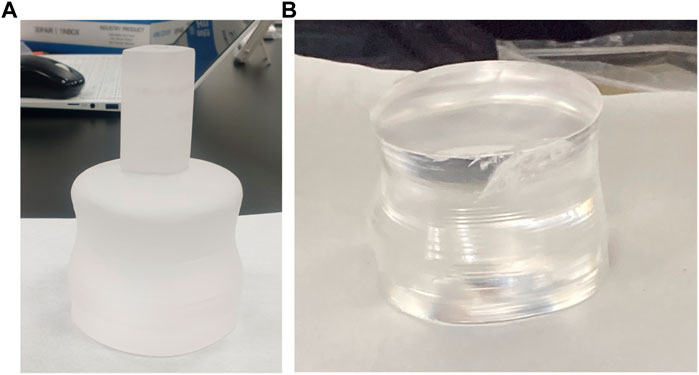
FIGURE 1. Bare NaI(Tl) (NaI-037) crystal. (A) NaI(Tl) crystal ingot. (B) cut and polished NaI(Tl) crystal.
3 Experimental setup
3.1 NaI(Tl) crystal
The growth of the NaI(Tl) crystal (named NaI-037) was completed on 18 January 2021, using NaI powder purified at IBS [24, 32]. The top and bottom sections of the crystal ingot were cut using a diamond bandsaw, as shown in Figure 1B. After cutting the top and bottom, the NaI-037 crystal is 70 mm in diameter and 51 mm in height. The flat top and bottom surfaces and a barrel-shaped side surface were polished using aluminum oxide films ranging from 400 to 8,000 grit. After the polishing, several layers of soft polytetrafluoroethylene (PTFE) film were wrapped on the barrel surface as a diffusive reflector. 3 mm thick optical pads (silicon rubber EJ-560) were coupled to the top and bottom surfaces as an optical interface. A 3 mm thick copper casing with 5 mm thick quartz windows at each end was encapsulated the crystal hermetically. Hamamatsu 3-inch R12669SEL photomultiplier tubes (PMTs) are coupled via an optical gel (EJ-550) to each end of the crystal. It is the same encapsulation design that was used for previous NaI crystal developments in Reference [28]. It is also similar to encapsulation used in the COSINE-100 [13] and the ANAIS-112 experiments. The entire assembly was performed in a glovebox, where the humidity was maintained to be less than 10 ppm (H2O) using Ar gas and a molecular sieve trap. Before the assembly, all parts were cleaned using diluted Citranox liquid with sonication and baked in a vacuum oven for more than 12 h. After assembly, the detector was delivered to the Yangyang underground laboratory (Y2L), which has ∼700 m of rock overburden [33]. From the crystal growth to Y2L delivery, it took less than 3 weeks and minimized the cosmogenic activation in the crystal.
3.2 Shielding structure
The background contamination levels of the NaI-037 crystal were evaluated using the same experimental apparatus as that used for the NaI(Tl) crystal R&D at the Y2L [28, 34]. It includes an array of 12 CsI(Tl) crystals surrounded by 10 cm copper, 5 cm polyethylene, 15 cm lead, and 30 cm liquid scintillator-loaded mineral oil [35, 36] as a radiation shield. The detector was installed inside the CsI(Tl) array, as shown in Figure 2.
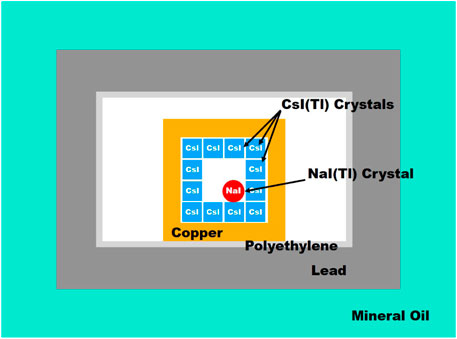
FIGURE 2. A schematic view of the Y2L setup. The NaI-037 crystal (red circle) was installed inside the CsI(Tl) crystal array (blue squares).
3.3 Electronics
The PMTs attached to the NaI-037 crystal had two readouts each, a high-gain signal from the anode and a low-gain signal from the fifth-stage dynode. The anode signal was amplified by a factor of 30, whereas the dynode signal was amplified by a factor of 100 using a custom-made preamplifier. The amplified signals were digitized by 500 MHz, 12-bit flash analog-to-digital converters (FADCs)1. Triggers from the individual channels were generated by the field-programmable gate arrays (FPGAs) embedded in the FADC. The final trigger was generated in the trigger and clock board (TCB)2 when an anode signal corresponding to one or more photoelectrons (PEs) occurred in each PMT within a 200 ns time window. The anode and dynode signals were recorded whenever the anode signal produced a trigger.
Signals from the CsI(Tl) crystals were amplified by a factor of 10 and digitized in a charge-sensitive 62.5 MHz FADC (SADC)3. The SADC provided the integrated charge and the time of the signal. An integration time of 2048 ns was used to record the CsI(Tl) signals considering their decay time. The SADC channels did not generate triggers.
If the trigger condition was satisfied, the TCB sent trigger signals to the FADC and SADC to store the signals from the NaI(Tl) and the CsI(Tl) crystals. The FADC stored an 8 μs long waveform starting approximately 2.4 μs before the time of the trigger position. The SADC stored the maximum integrated charge within an 8 μs search window. This system is similar to the one used in the COSINE-100 data acquisition [37].
3.4 Energy calibration and light yields
The energy calibration of the anode signal was done using a 59.54 keV X-ray emitted from 241Am. Figure 3 shows the anode energy spectrum. A clear peak at 59.54 keV resulting from the 241Am source is shown together with the 127I X-ray escape peak around 30 keV. The dynode signal was calibrated using the photopeaks corresponding to 214Bi (609 keV) and 40K (1460 keV) contaminants in the crystal.
The charge distribution of the single photoelectron (SPE) was obtained by identifying the isolated clusters at the decay tail of the 59.54 keV X-ray signal from the 241Am source (3–5 μs after the signal start). The light yield was determined from the ratio of the total deposited charge and the mean of the SPE charge for the 59.54 keV X-ray data. In this crystal, a light yield of 17.8 ± 0.6 number of photoelectron (NPE)/keV was obtained. It is similar to the result for the NaI-036 crystal, which has the highest light yield among the previously developed low-background NaI(Tl) crystals using the Astro-grade powder [28]. This light yield is also larger than those of the detectors used in the COSINE-100 and DAMA/LIBRA experiments, as summarized in Table 1.

TABLE 1. Measured radioactive contaminants in the NaI-037 crystal, C6 of COSINE-100 [30], DAMA crystals [39, 42], and the previously grown NaI-035 and NaI-036 crystals using the Astro-grade powder [28].The upper limits are given at a 90% confidence level. The 210Pb value is the rate at the equilibrium state.
4 Understanding the background in the spectrum
4.1 40K background
40K is one of the most problematic background sources in the search for weakly interacting massive particles (WIMP) using NaI(Tl) crystals. The X-rays/Auger electrons from 40K decays produce 3.2 keV energy signals, similar to the energy signals expected for a WIMP-nuclei interaction [30, 31, 38]. The 40K decays also emit 1460 keV γ rays, which can escape from the NaI(Tl) crystal and hit the surrounding CsI(Tl) crystals, leading to a double coincidence with the 3.2 keV X-rays.
Figure 4 shows the tagged low-energy spectra from the NaI(Tl) crystal by requiring the detection of the 1460 keV γ ray in the CsI(Tl) crystals. The 40K background level in the NaI(Tl) crystal was determined by comparing the measured coincidence rate from a GEANT4-based simulated data, as described in Reference [11]. By accumulating more than 6 months of data, the K level was measured to be 8.3 ± 4.6 ppb, which was compared with the other NaI(Tl) crystals listed in Table 1. It is well below our goal of 20 ppb, consistent with the results from the DAMA/LIBRA crystals [34, 39] and previously developed NaI-035 and NaI-036 crystals with the Astro-grade powder.
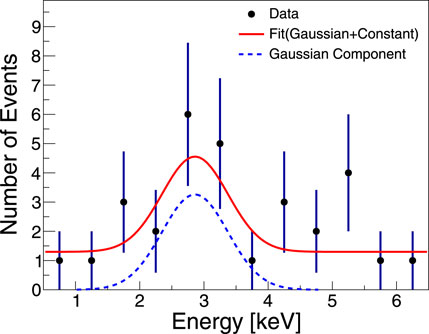
FIGURE 4. Energy deposition of the 3.2 keV 40K coincidence events in the NaI-037 crystal. The model of the energy spectrum assumes a combination of a Gaussian 40K signal and a constant background.
4.2 α analysis
Alpha-induced events inside the NaI(Tl) crystals can be identified using the fast decay times of their corresponding signals. The charge-weighted duration time, called the meantime, is defined as
where A and t are the charge and time of the i-th digitized bin of a signal waveform, respectively. The meantime is estimated within 1500 ns from the pulse starting timing. Figure 5 shows a scatter plot of the energy versus the meantime for the NaI-037 crystal. In the figure, the populations of γ/β and α events can be separated clearly due to the faster decay times of the α-induced events.
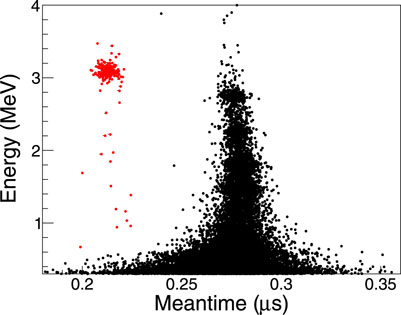
FIGURE 5. Scatter plot of the meantime versus the energy distribution events measured over 7.8 days for the NaI-037 crystal. The α events (red dots) and the γ/β events (black dots) are separated clearly.
4.3 210Pb background
In the NaI(Tl) crystal experiments, the dominant background source in the low-energy signal region is from 210Pb [31, 40, 41]. The 210Pb activity can be estimated from the alpha-decay studies, because the α decays of 210Po originate from the β decays of 210Pb. Due to the decay time of 200 days of 210Po, the amount of 210Pb produced can be estimated using a time-dependent fit of the alpha rate as follows:
where N is the total alpha rate, NPb210 is the amount of 210Pb at the equilibrium state, t0 is the time difference between 210Pb contamination and the start time of data taking, τPo210 is the mean lifetime of 210Po, approximately 200 days, and C represents the long-lived components from 238U and 232Th chains. Figure 6 shows the measured total alpha rates in the NaI-037 crystal over 4.5 months of detector running time. The 210Pb activity in the crystal was estimated to be 0.38 ± 0.10 mBq/kg, which is lower than the COSINE-100 crystals and is consistent with the activity in the NaI-036 crystal produced using the Astro-grade powder. However, this activity is slightly higher than the DAMA crystals and another crystal NaI-035 grown with the same Astro-grade powder. The 0.4 mBq/kg level contamination of 210Pb is enough to reach 1 count/kg/keV/day background level in the 1–6 keV energy region, similar to the activity in the DAMA/LIBRA detectors, as described in Reference [28].
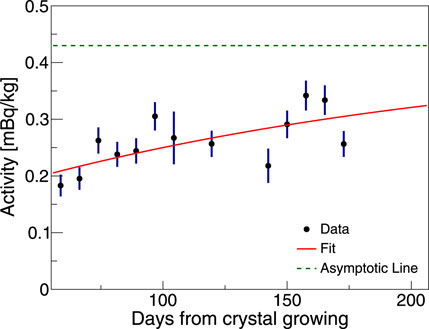
FIGURE 6. The total alpha rate in the NaI-037 crystal as a function of time, modeled with 210Po assuming contamination of 222Rn (and/or 210Pb). The asymptotic line corresponds to the rate of total alpha events in the equilibrium state, including other α sources such as Th and U.
4.4 232Th background
Contaminants from the 228Th subchain in the 232Th family can be estimated by exploiting the time-delayed α–α coincident events of 220Rn and 216Po. The alpha decay of 216Po has a half-life of 0.145 s following its production via alpha decay of 220Rn. Owing to the short half-life of 216Po, it is straightforward to select two successive α particles with almost no random coincident events.
The presence of the coincident events with 4.5 months of exposure is shown in Figure 7A as the distribution of the time gap between those two α events. The exponential component indicates the contamination from 232Th, corresponding to below 0.78 ppt (90% confidence level). The 232Th concentration in the NaI-037 crystal is the lowest among the other NaI(Tl) crystals, as summarized in Table 1.
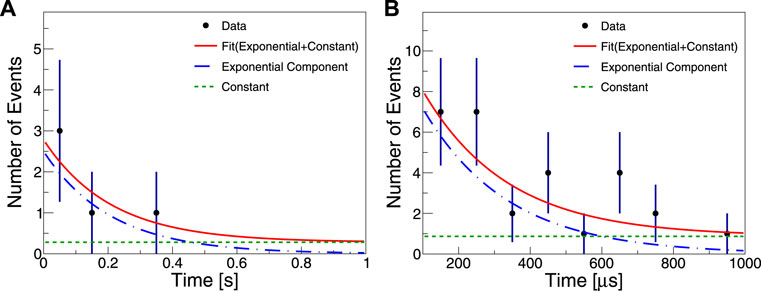
FIGURE 7. The total alpha rate in the NaI-037 crystal as a function of time, modeled with 210Po assuming contamination of 222Rn (and/or 210Pb). The asymptotic line corresponds to the rate of total alpha events in the equilibrium state, including other α sources such as Th and U. (A) Time difference between two α decays of the 220Rn–216Po decay chain. (B) Time difference between the 214Po α decay and 214Bi β decay.
4.5 238U background
238U is one of the common radioisotopes because of its long half-life. The 238U content in the background can be studied using the time-delayed β–α coincident events of this radioactive chain, similar to the calculation of the 232Th background. This method exploits the α decay of 214Po with a half-life of 164.3 μs, while 214Bi, the parent particle of 214Po, undergoes β decay. Due to the 50 μs dead time of the trigger system, the coincident events with delay times greater than 50 μs can be tagged. The results with 4.5 months of exposure are shown in Figure 7. The 238U activity of NaI-037 was below 1.98 ppt (90% confidence level, similar to that observed for the other NaI(Tl) crystals, as given in Table 1.
4.6 External background
Because of the small size of the NaI-037 crystal and no liquid scintillator active veto, a significantly higher background contribution is expected from the external background compared to those found in the COSINE-100 crystals [30, 40]. The PMTs attached to the NaI(Tl) and the CsI(Tl) crystals are the primary sources of external background. In this study, the external background contributions were simulated using the GEANT4-based simulation toolkit used for the COSINE-100 background modeling [30, 40].
4.7 Cosmogenic radionuclides
The cosmogenic production of radioactive isotopes in the NaI(Tl) crystal is mainly due to long-lived nuclides such as 3H and 22Na [30, 43]. The NaI-037 crystal was grown in Daejeon, Korea (70 m in altitude) and delivered underground within a month. Based on the previous study, 1-month exposure time near sea level can produce 0.004 mBq/kg of 3H and 0.05 mBq/kg of 22Na [43], respectively.
5 Background modeling
For a quantitative understanding of the background in the NaI-037 crystal, GEANT4-based simulation, developed for the background modeling of the COSINE-100 NaI(Tl) crystals [30, 40] and also used in the previously grown crystals using the Astro-grade powder [28], was performed. The input values of the contamination levels are obtained from Table 1. A simultaneous fit was done to the single-hit low energy (2–60 keV), single-hit high energy (60–3,000 keV), multiple-hit low energy, and multiple-hit high energy events using the log-likelihood method. A multiple-hit event corresponds to one or more coincident hits in any of the surrounding CsI(Tl) crystals. The backgrounds from the PMTs attached to the NaI(Tl) and CsI(Tl) crystals were measured using a high-purity germanium detector [30, 31]. These values were constrained to be within 50% of the measured result because the exact locations of such radioisotopes are uncertain. The long-lived cosmogenic radioisotopes were constrained to be within 50% of their calculation production values whereas the other short-lived cosmogenic components were floated. In this modeling, we do not consider systematic uncertainties for simplicity. Figure 8; Table 2 show the fitted results for the NaI-037 crystal on all simulated background components and the summary of the fitted radioactive contaminants, respectively. The overall energy spectra match the data for the single-hit and multiple-hit events satisfactorily. The level of the fitted internal components is similar to the previously grown NaI-036 crystal [28]. The external background is the dominant contributor due to the small size of the crystal and no active veto detector used in the COSINE-100 experiment [13]. However, this contribution will be significantly reduced with the large-size crystals similar to the COSINE-100 detector with the active veto detector as discussed in Reference [28].
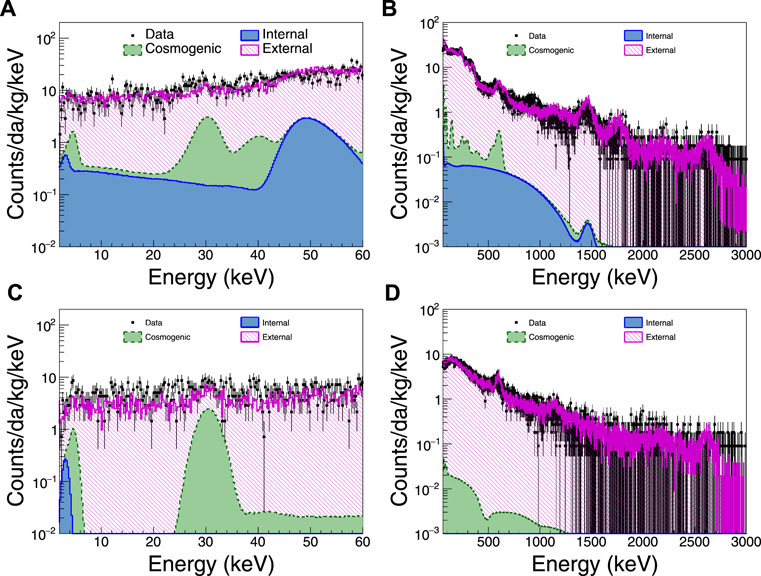
FIGURE 8. Measured single-hit and multiple-hit background spectra of the NaI-037 (black point) crystal fitted with the different simulated background components using a simultaneous fit of four channels using the log-likelihood method. (A) Single-hit low-energy (2–60 keV). (B) Single-hit high-energy (60–3000 keV). (C) Multiple-hit low-energy (2–60 keV). (D) Multiple-hit high-energy (60–3000 keV).
The expected background level in the COSINE-200 crystal can be studied from the simulated background by assuming a 12.5 kg detector in the COSINE-100 shielding, as described in Reference [28]. If the measured backgrounds, given in Table 2 for the simulated study, are considered, a background level of approximately 0.5 counts/kg/keV/day in the 1–6 keV energy region is obtained, which is similar to the result for the NaI-036 crystal in the previous study [28]. It is a few tens times higher than DAMA crystals owing to the higher 210Pb contamination. However, it is still less than 1 count/kg/keV/day, the target background level for the COSINE-200 experiment.
6 Conclusion
In this article, we presented the performance of the first ultra-low background NaI(Tl) crystal produced using the direct purification of the NaI powder in our facility as a part of a program for the next-generation COSINE-200 experiment. The results of this study show a similar quantity of internal background contamination in the crystals grown using commercial Astro-grade powder. It indicates that the direct powder purification and crystal growth procedures employed at our facility can provide suitable NaI(Tl) crystals for the COSINE-200 experiment. Based on the experience of developing ultra-pure NaI(Tl) crystals, we are moving to full-size crystal growth with our purified powder.
Data availability statement
The original contributions presented in the study are included in the article/Supplementary Material, further inquiries can be directed to the corresponding author.
Author contributions
All authors listed have made a substantial, direct, and intellectual contribution to the work and approved it for publication.
Funding
This work is supported by the Institute for Basic Science (IBS) under the project code IBSR016-A1 and NRF-2021R1A2C1013761.
Acknowledgments
We thank Korea Hydro and Nuclear Power Co., Ltd. (KHNP) for providing the underground laboratory space at Yangyang and the IBS Research Solution Center (RSC) for providing high performance computing resources.
Conflict of interest
AI was employed by Damavan Imaging company.
The remaining authors declare that the research was conducted in the absence of any commercial or financial relationships that could be construed as a potential conflict of interest.
Publisher’s note
All claims expressed in this article are solely those of the authors and do not necessarily represent those of their affiliated organizations, or those of the publisher, the editors and the reviewers. Any product that may be evaluated in this article, or claim that may be made by its manufacturer, is not guaranteed or endorsed by the publisher.
Footnotes
1FADC500 in NOTICE CO. Ltd.
2MiniTCB in NOTICE CO. Ltd.
3M64ADC in NOTICE CO. Ltd.
References
1. Clowe D, Bradac M, Gonzalez AH, Markevitch M, Randall SW, Jones C, et al. A direct empirical proof of the existence of dark matter. Astrophys J (2006) 648:L109–13. doi:10.1086/508162
2. Aghanim N, Akrami Y, Ashdown M, Aumont J, Baccigalupi C, Ballardini M, et al. Planck 2018 results. VI. Cosmological parameters. Astron Astrophys (2020) 641:A6. [Erratum: Astron.Astrophys. 652, C4 (2021)]. doi:10.1051/0004-6361/201833910
3. Bertone G, Hooper D. History of dark matter. Rev Mod Phys (2018) 90:045002. doi:10.1103/RevModPhys.90.045002
4. Undagoitia TM, Rauch L. Dark matter direct-detection experiments. J Phys G (2016) 43:013001. doi:10.1088/0954-3899/43/1/013001
5. Schumann M. Direct detection of WIMP dark matter: Concepts and status. J Phys G (2019) 46:103003. doi:10.1088/1361-6471/ab2ea5
6. Bernabei R, Belli P, Cappella F, Caracciolo V, Castellano S, Cerulli R, et al. Final model independent result of DAMA/LIBRA-phase1. Eur Phys J C (2013) 73:2648. doi:10.1140/epjc/s10052-013-2648-7
7. Bernabei R, Belli P, Bussolotti A, Cappella F, Caracciolo V, Cerulli R, et al. First model independent results from DAMA/LIBRA-phase2. Nucl Phys Atom Energ (2018) 19:307–25. doi:10.15407/jnpae2018.04.307
8. Savage C, Gelmini G, Gondolo P, Freese K. Compatibility of DAMA/LIBRA dark matter detection with other searches. JCAP (2009) 0904:010. doi:10.1088/1475-7516/2009/04/010
9. Ko YJ, Adhikari G, Adhikari P, de Souza EB, Carlin N, Choi J, et al. Comparison between DAMA/LIBRA and COSINE-100 in the light of quenching factors. JCAP (2019) 1911:008. doi:10.1088/1475-7516/2019/11/008
10. Workman RL, Burkert VD, Crede V, Klempt E, Thoma U, Tiator L, et al. Review of particle physics. PTEP (2022) 2022:083C01. doi:10.1093/ptep/ptac097
11. Kim KW, Kang W, Oh S, Adhikari P, So J, Kim N, et al. Tests on NaI(Tl) crystals for WIMP search at the Yangyang underground laboratory. Astropart Phys (2015) 62:249–57. doi:10.1016/j.astropartphys.2014.10.004
12. Antonello M, Barberio E, Baroncelli T, Benziger J, Bignell LJ, Bolognino I, et al. The SABRE project and the SABRE Proof-of-Principle. Eur Phys J C (2019) 79:363. doi:10.1140/epjc/s10052-019-6860-y
13. Adhikari G, Adhikari P, de Souza EB, Carlin N, Choi S, Choi WQ, et al. Initial performance of the COSINE-100 experiment. Eur Phys J C (2018) 78:107. doi:10.1140/epjc/s10052-018-5590-x
14. Fushimi KI. Low background measurement by means of NaI(Tl) scintillator: Improvement of sensitivity for cosmic dark matter. RADIOISOTOPES (2018) 67:101–11. doi:10.3769/radioisotopes.67.101
15. Coarasa I, Amare J, Cebrian S, Cuesta C, Garcia E, Martinez M, et al. ANAIS-112 sensitivity in the search for dark matter annual modulation. Eur Phys J C (2019) 79:233. doi:10.1140/epjc/s10052-019-6733-4
16. Amare J, Cebrian S, Coarasa I, Cuesta C, Garcia E, Martinez M, et al. Performance of ANAIS-112 experiment after the first year of data taking. Eur Phys J C (2019) 79:228. doi:10.1140/epjc/s10052-019-6697-4
17. Suerfu B, Wada M, Peloso W, Souza M, Calaprice F, Tower J, et al. Growth of ultra-high purity NaI(Tl) crystals for dark matter searches. Phys Rev Res (2020) 2:013223. doi:10.1103/PhysRevResearch.2.013223
18. Adhikari G, Adhikari P, de Souza EB, Carlin N, Choi S, Djamal M, et al. An experiment to search for dark-matter interactions using sodium iodide detectors. Nature (2018) 564:83–6. doi:10.1038/s41586-018-0739-1
19. Adhikari G, de Souza EB, Carlin N, Choi JJ, Choi S, Djamal M, et al. Strong constraints from COSINE-100 on the DAMA dark matter results using the same sodium iodide target. Sci Adv (2021) 7:abk2699. doi:10.1126/sciadv.abk2699
20. Adhikari G, Carlin N, Choi J, Choi S, Ezeribe A, Franca L, et al. Searching for low-mass dark matter via the Migdal effect in COSINE-100. Phys Rev D (2022) 105:042006. doi:10.1103/PhysRevD.105.042006
21. Adhikari G, Carlin N, Choi JJ, Choi SH. An induced annual modulation signature in COSINE-100 data by DAMA/LIBRA’s analysis method. arXiv:2208.05158 (2022).
22. Adhikari G, Adhikari P, de Souza EB, Carlin N, Choi S, Djamal M, et al. Search for a dark matter-induced annual modulation signal in NaI(Tl) with the COSINE-100 experiment. Phys Rev Lett (2019) 123:031302. doi:10.1103/PhysRevLett.123.031302
23. Adhikari G, Barbosa de Souza E, Carlin N, Choi J, Choi S, Ezeribe A, et al. Three-year annual modulation search with COSINE-100. Phys Rev D (2022) 106:052005. doi:10.1103/PhysRevD.106.052005
24. Shin K, Gileva O, Kim Y, Lee HS, Park H. Reduction of the radioactivity in sodium iodide (NaI) powder by recrystallization method. J Radioanal Nucl Chem (2018) 317:1329–32. doi:10.1007/s10967-018-6006-y
25. Shin K, Choe J, Gileva O, Iltis A, Kim Y, Lee C, et al. A facility for mass production of ultra-pure NaI powder for the COSINE-200 experiment. JINST (2020) 15:C07031. doi:10.1088/1748-0221/15/07/C07031
26. Ra S, Lee C, Kim D, Son J, Choe J, Shin K, et al. Scintillation crystal growth at the CUP. PoS (2019) ICHEP2018:668. doi:10.22323/1.340.0668
27. Choi J, Park B, Ha C, Kim K, Kim S, Kim Y, et al. Improving the light collection using a new NaI(Tl)crystal encapsulation. Nucl Instrum Meth A (2020) 981:164556. doi:10.1016/j.nima.2020.164556
28. Park B, Choi JJ, Choe JS, Gileva O, Ha C, Iltis A, et al. Development of ultra-pure NaI(Tl) detectors for the COSINE-200 experiment. Eur Phys J C (2020) 80:814. doi:10.1140/epjc/s10052-020-8386-8
29. Shin K, Choe J, Gileva O, Iltis A, Kim Y, Kim Y, et al. Mass production of ultra-pure NaI powder for COSINE-200. Paper in preparation (2023).
30. Adhikari P, Adhikari G, Souza EB, Carlin N, Choi S, Choi WQ, et al. Background model for the NaI(Tl) crystals in COSINE-100. Eur Phys J C (2018) 78:490. doi:10.1140/epjc/s10052-018-5970-2
31. Adhikari G, Adhikari P, Ha C, Jeon EJ, Kim NY, Kim YD, et al. Understanding NaI(Tl) crystal background for dark matter searches. Eur Phys J C (2017) 77:437. doi:10.1140/epjc/s10052-017-5011-6
32. Ra SJ, Kim DY, Lee CH, Son JK, Shin KA, Gileva O, et al. Status of ultra-pure scintillating crystal growth for rare process experiments by CUP. JPCS (2020) 1468:012144. doi:10.1088/1742-6596/1468/1/012144
33. Prihtiadi H, Adhikari G, Adhikari P, de Souza EB, Carlin N, Choi S, et al. Muon detector for the COSINE-100 experiment. JINST (2018) 13:T02007. doi:10.1088/1748-0221/13/02/T02007
34. Adhikari P, Adhikari G, Choi S, Ha C, Hahn IS, Jeon EJ, et al. Understanding internal backgrounds in NaI(Tl) crystals toward a 200 kg array for the KIMS-NaI experiment. Eur Phys J C (2016) 76:185. doi:10.1140/epjc/s10052-016-4030-z
35. Lee HS, Bhang H, Choi J, Hahn I, He D, Hwang M, et al. First limit on WIMP cross section with low background CsI(Tℓ) crystal detector. Phys Lett B (2006) 633:201–8. doi:10.1016/j.physletb.2005.12.035
36. Lee HS, Bhang H, Hahn IS, Hwang MJ, Kim HJ, Kim SC, et al. Development of low-background CsI(Tl) crystals for WIMP search. Nucl Instrum Meth A (2007) 571:644–50. doi:10.1016/j.nima.2006.10.325
37. Adhikari G, Adhikari P, de Souza EB, Carlin N, Choi S, Choi W, et al. The COSINE-100 data acquisition system. JINST (2018) 13:P09006. doi:10.1088/1748-0221/13/09/P09006
38. Amare J, Cebrian S, Coarasa I, Cuesta C, Garcia E, Martinez M, et al. Analysis of backgrounds for the ANAIS-112 dark matter experiment. Eur Phys J C (2019) 79:412. doi:10.1140/epjc/s10052-019-6911-4
39. Bernabei R, Belli P, Bussolotti A, Cappella F, Cerulli R, Dai C, et al. The DAMA/LIBRA apparatus. Nucl Instrum Meth A (2008) 592:297–315. doi:10.1016/j.nima.2008.04.082
40. Adhikari G, de Souza EB, Carlin N, Choi JJ, Choi S, Djamal M, et al. Background modeling for dark matter search with 1.7 years of COSINE-100 data. Eur Phys J C (2021) 81:837. doi:10.1140/epjc/s10052-021-09564-0
41. Fushimi K, Kanemitsu Y, Hirata S, Chernyak D, Hazama R, Ikeda H, et al. Development of highly radiopure NaI(Tl) scintillator for PICOLON dark matter search project. PTEP (2021) 2021:043F01. doi:10.1093/ptep/ptab020
42. Bernabei R, Belli P, Bussolotti A, Cappella F, Caracciolo V, Casalboni M, et al. Performances of the new high quantum efficiency pmts in dama/libra. JINST (2012) 7:P03009. doi:10.1088/1748-0221/7/03/P03009
Keywords: NaI(Tl) crystal, dark matter, COSINE-200, low-background detectors, purification
Citation: Lee H, Park BJ, Choi JJ, Gileva O, Ha C, Iltis A, Jeon EJ, Kim DY, Kim KW, Kim SH, Kim SK, Kim YD, Ko YJ, Lee CH, Lee HS, Lee IS, Lee MH, Ra SJ, Son JK and Shin KA (2023) Performance of an ultra-pure NaI(Tl) detector produced by an indigenously-developed purification method and crystal growth for the COSINE-200 experiment. Front. Phys. 11:1142765. doi: 10.3389/fphy.2023.1142765
Received: 12 January 2023; Accepted: 06 February 2023;
Published: 21 February 2023.
Edited by:
Luca Pattavina, Gran Sasso National Laboratory (INFN), ItalyReviewed by:
Alessio Caminata, Istituto Nazionale di Fisica Nucleare di Genova, ItalyAldo Ianni, Gran Sasso National Laboratory (INFN), Italy
Copyright © 2023 Lee, Park, Choi, Gileva, Ha, Iltis, Jeon, Kim, Kim, Kim, Kim, Kim, Ko, Lee, Lee, Lee, Lee, Ra, Son and Shin. This is an open-access article distributed under the terms of the Creative Commons Attribution License (CC BY). The use, distribution or reproduction in other forums is permitted, provided the original author(s) and the copyright owner(s) are credited and that the original publication in this journal is cited, in accordance with accepted academic practice. No use, distribution or reproduction is permitted which does not comply with these terms.
*Correspondence: I. S. Lee, aXNsZWVAaWJzLnJlLmty
 H. Lee
H. Lee B. J. Park1,2
B. J. Park1,2 O. Gileva
O. Gileva S. H. Kim
S. H. Kim H. S. Lee
H. S. Lee I. S. Lee
I. S. Lee M. H. Lee
M. H. Lee K. A. Shin
K. A. Shin